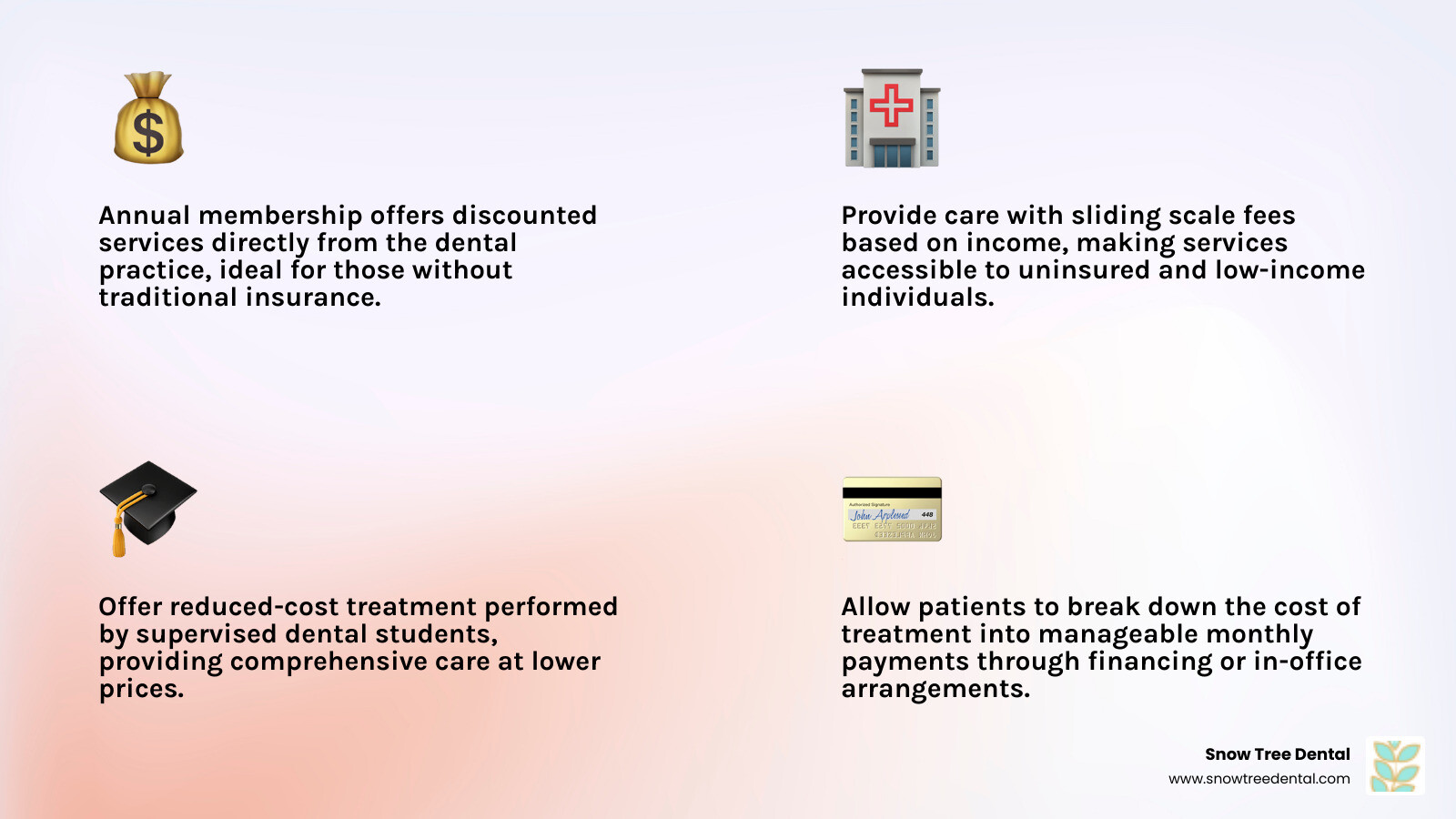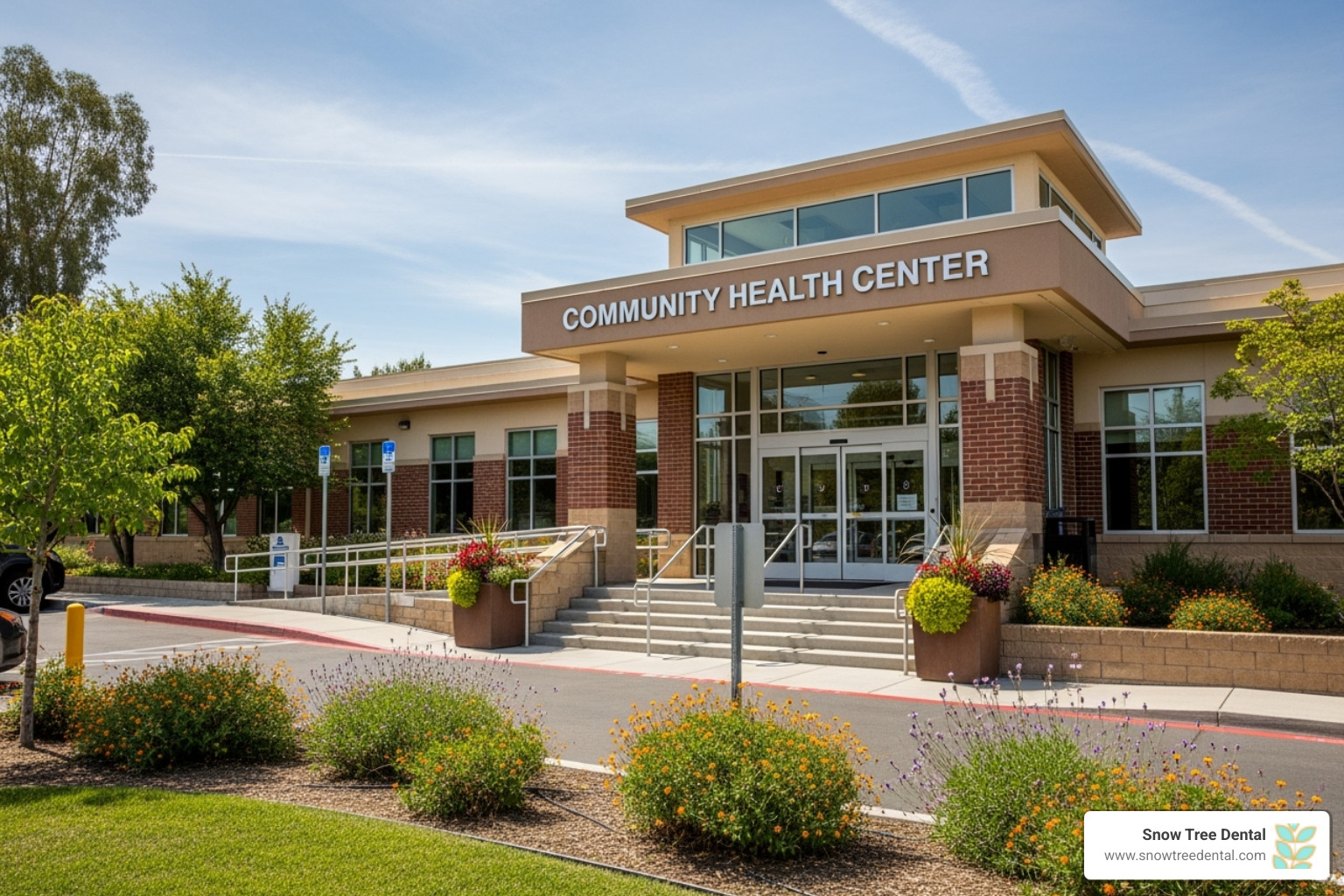Low cost dental: Smart Savings 2025
Why Affordable Dental Care Matters for Your Health and Budget
Low cost dental options can make the difference between getting the care you need and living with painful, worsening dental problems. Many Houston families put off dental visits because of cost concerns, but delaying treatment often leads to more expensive emergency procedures down the road.
Quick Answer: Your Low-Cost Dental Options
- In-office dental savings plans – Annual membership with discounted services
- Community health centers – Sliding scale fees based on income
- Dental education clinics – Student-provided care under supervision
- Government programs – Coverage for eligible low-income individuals
- Flexible payment plans – Break treatment costs into manageable payments
The reality is that dental problems don’t wait for better financial times. A small cavity can turn into an expensive root canal, and gum disease can lead to tooth loss requiring costly replacements. The good news? Multiple pathways exist to make dental care affordable, from government-funded programs to private practice payment plans.
Financial barriers shouldn’t prevent you from maintaining good oral health. Whether you’re uninsured, underinsured, or simply looking to reduce out-of-pocket costs, this guide will show you practical ways to access quality dental care without breaking your budget.
As Dr. Muna Mohammad, a practicing dentist in Houston at Snow Tree Dental, I’ve seen how low cost dental solutions can transform patients’ lives by making essential care accessible. My experience has shown me that affordable doesn’t mean compromising on quality – it means finding the right program or payment option for your specific situation.

Understanding Your Options for Affordable Dental Care
Finding low cost dental care doesn’t have to feel overwhelming. Think of it like shopping for anything else important – once you know what options are available, you can choose what works best for your situation and budget.

The good news is that several different pathways exist to make dental care affordable. Local public health initiatives serve communities through government funding, while dental education programs offer supervised student care at reduced rates. Community clinics provide sliding-scale fees based on what you can afford, and non-profit organizations sometimes offer free services to those who need them most.
Each option has its own personality, if you will. Some focus on speed and convenience, others on comprehensive care, and some specifically target families facing financial hardship. Understanding these differences helps you find the perfect fit.
In-Office Dental Savings Plans
Here’s something many people don’t know about: in-house dental savings plans are becoming a game-changer for families without traditional dental insurance. Instead of dealing with complicated insurance companies, you work directly with your dental practice.
The concept is refreshingly simple. You pay an annual membership fee directly to the dental office, and in return, you get discounted services throughout the year. No monthly premiums, no confusing paperwork, no waiting for approval on treatments you need.
Who can benefit from these plans? Pretty much anyone who wants predictable dental costs. Families without employer insurance love them. Small business owners find them practical. Even people with insurance sometimes find that these plans offer better value for their specific needs.
At Snow Tree Dental, our Affordable Dental Plan works exactly this way. You become a member, and immediately start saving on everything from routine cleanings to more complex procedures. No waiting periods, no annual maximums, no surprises.
Community Health Centers and Public Clinics
Community Health Centers (CHCs) are like the neighborhood heroes of healthcare. These centers exist specifically to serve uninsured patients and low-income populations, offering dental services alongside medical care.
Here’s what makes them special: they use sliding scale fees based on your income. The less you earn, the less you pay. Some services might even be free if your financial situation qualifies you.
These centers typically handle basic dental services like cleanings, fillings, and extractions. Many also provide emergency care when you’re dealing with severe pain or infection. They’re not fancy, but they’re reliable and accessible.
How to find local clinics near you? Start by searching online for “community health center” plus your city name. Contact your local health department – they usually keep lists of all the CHCs in your area. You can also call 211 (in most areas) for referrals to local resources.
Dental Education Clinics and Hygiene Programs
If you’ve never considered getting dental care at a university, you’re missing out on one of the best-kept secrets in low cost dental care. Dental education clinics offer reduced-cost treatment that’s performed by student dentists and hygienists under careful supervised care.
Before you worry about the “student” part – these aren’t beginners working alone. Every procedure is closely monitored by experienced, licensed faculty members. Think of it as getting two dentists for the price of less than one.
The trade-off is time. Longer appointment times are normal because students need to check their work with supervisors. But you’ll often receive incredibly thorough care and comprehensive services ranging from basic cleanings to complex procedures.
The University of Toronto runs an excellent program with multiple clinics. You can find more info about University of Toronto’s dental clinics to see how these programs typically work. Many major universities in the US offer similar programs.
Non-Profits and Charitable Organizations
Sometimes the most heartwarming dental care comes from volunteer dentists and charitable organizations who donate their time and skills. These free clinics often target specific populations like veterans, people experiencing homelessness, or families in crisis.
Donated services typically include the essentials: exams, cleanings, fillings, and extractions. Some organizations also provide emergency pain relief when people have nowhere else to turn.
Homeless outreach programs sometimes bring dental care directly to shelters or community centers. These mobile clinics can be lifesavers for people who can’t easily get to traditional dental offices.
The catch? These programs usually have strict eligibility requirements and long waiting lists. They’re incredible resources, but they can’t serve everyone who needs help. Still, if you’re facing a true financial emergency, they’re worth investigating in your community.
Who Qualifies and What Services Are Covered?
Understanding the types of low cost dental programs is just the first step. The real question is: Will you qualify, and what can you actually get done? This is where things get practical, because every program has its own rules about who gets in and what treatments they’ll cover.
Think of it like applying for any other assistance program – there are hoops to jump through, but once you understand the system, it becomes much easier to steer. We’ll walk you through the common requirements, show you what services are typically available, and help you weigh the pros and cons of different options.
Eligibility for Low-Cost Dental Care
Most low cost dental programs focus on one main thing: helping people who genuinely need financial assistance. The good news is that if you’re struggling with dental costs, you probably qualify for something.
Income is usually the biggest factor. Programs want to see that you’re not just looking for a deal, but that you actually need help affording care. You’ll typically need to provide recent pay stubs, tax returns, or benefit statements. For example, some programs set their income limits quite high – like $90,000 per year for households – recognizing that even middle-income families can struggle with dental costs.
Not having dental insurance is often a requirement too. Many programs specifically target the uninsured or those whose insurance doesn’t cover enough. If your employer plan only covers basic cleanings but you need a root canal, you might still qualify as “underinsured.”
Age can open or close doors. Some programs are just for kids and teens, while others focus on seniors. There are also programs specifically for adults with disabilities or those receiving government assistance. If you’re caring for someone with special needs, they might automatically qualify for certain programs.
Where you live matters. Most programs serve specific geographic areas, so you’ll need proof of local residency. This could be a utility bill, lease agreement, or driver’s license showing your current address.
The key is not to assume you don’t qualify. Requirements vary widely between programs, and what disqualifies you from one might make you perfect for another.
Typical Services in Low-Cost Dental Programs
When you hear “low cost dental,” you might wonder if that means limited options. The reality is more encouraging than you might think. Most affordable programs cover the essentials that keep your mouth healthy and address urgent problems.
Preventive care is almost always included because it makes financial sense for everyone. Regular Preventative Dentistry like cleanings, exams, and X-rays helps catch problems early before they become expensive emergencies. Most programs prioritize these services because preventing a cavity costs far less than treating an infected tooth later.
Basic restorative work usually makes the cut too. This means fillings for cavities, simple extractions for teeth that can’t be saved, and treatment for infections or abscesses. These aren’t luxury services – they’re necessary to keep you out of pain and prevent more serious health problems.
Emergency care is typically available because dental emergencies don’t wait for convenient timing or better finances. Whether it’s severe pain, swelling, or trauma, most programs have provisions for urgent situations.
However, there are usually clear boundaries about what’s not covered. Cosmetic procedures like teeth whitening or veneers are generally off-limits since they’re not medically necessary. Orthodontics like braces are rarely covered unless there’s a severe functional problem. Complex procedures like dental implants might be available in some programs but often with significant waiting lists or co-pays.
The scope of General Dentistry services varies by program, but most focus on keeping you comfortable and healthy rather than perfect.
Comparing Program Benefits and Limitations
Here’s where the rubber meets the road. Each type of low cost dental program has trade-offs, and understanding them helps you choose wisely.
| Program Type | Cost | Wait Times | Service Scope |
|---|---|---|---|
| Dental Education Clinics | Very low cost, often 50-70% savings | Longer appointments, moderate wait for scheduling | Comprehensive, including complex procedures |
| Community Health Centers | Sliding scale based on income, can be very affordable | Varies widely, emergency slots usually available | Basic to moderate services, focus on essential care |
| In-Office Savings Plans | Annual fee plus discounted services, predictable costs | Usually immediate availability | Full range of services offered by that practice |
The affordability factor is obvious – these programs exist because regular dental care costs too much for many people. You’ll typically save 30-70% compared to standard fees, which can mean the difference between getting treatment and going without.
But there are trade-offs to consider. Wait times can be frustrating, especially if you’re in pain. Some programs have months-long waiting lists for non-emergency care. Service limitations might mean you can get a tooth extracted but not replaced with an implant.
Quality concerns are understandable but often unfounded. Dental education clinics must meet the same standards as private practices, just with more supervision. Community health centers are licensed and regulated just like any other dental office.
The key is matching your needs with the right program. If you need immediate care and have some budget flexibility, an in-office plan might work best. If you can wait and want maximum savings, a dental education clinic could be perfect. For true emergencies with no money, community health centers often provide the safety net you need.




